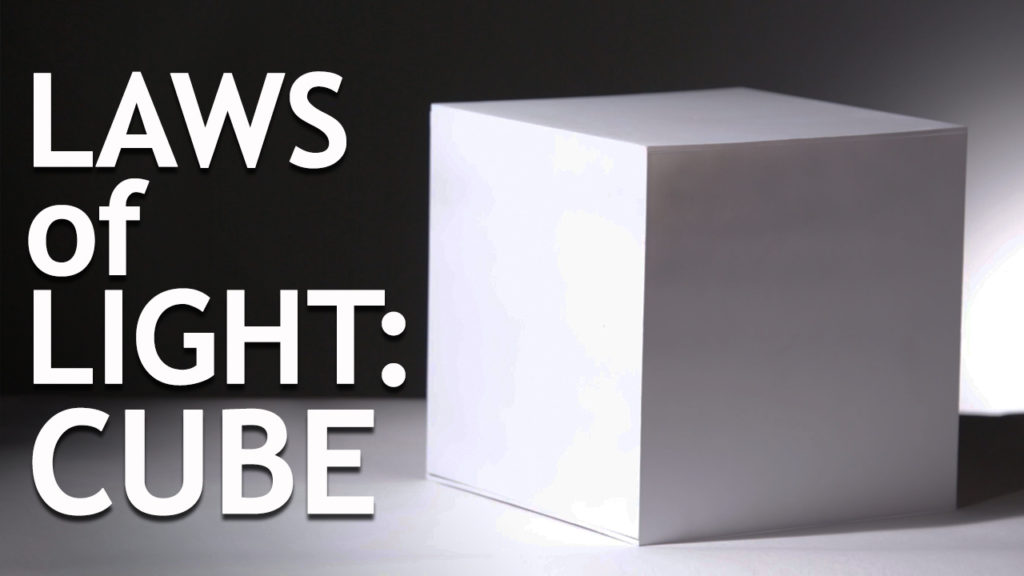Laws of Light: Cube
Hi, this is Jay P. Morgan. Welcome back to our series on the Laws of Light. If you didn’t watch the first, you’ll want to go back and start there. A cube is an interesting subject matter because it relates to a lot of things that a photographer or videographer has to work with. These are principles that I was taught by Charlie Potts, the head of the photo department at Art Center College of Design. Hopefully, you can build on it as I have, and it will become a part of the way you light and the way you see the world through your photographic lens.
Cube
A cube has six surfaces. Unfortunately, in a two-dimensional experience, you only see three of them. So we need to understand how to light three distinct surfaces of a cube. Remember, cameras are not your tool. Cameras are simply what you use to record light that’s been placed in front of you. Without light, you don’t have an image. Light is our tool. Let’s talk about the qualities of light, and help us to understand them so we can apply them to our imagery. Let’s get started, see what we can do.
Depth
First, we’re going to turn our light on. Some of the same things that happened with our sphere are going to happen with our cube. The difference is that now we have the hard lines of the cube vs the round surface of the sphere. We have a highlight side, we have a shadow side, but then we have a third, flat dimension. Now, if you’re going to light a cube correctly, you’ll want each one of these to have a different value. That will give it dimension- a sense of depth in a two-dimensional experience. So, if a side of the cube is just as hot as the top of the cube, and the other side is really dark, it’s really just a two-dimensional experience. You won’t see all three dimensions. If it’s lit correctly, each of the sides will have a different dimension. This relates to cheese, it relates to a cereal box, it relates to anything that has multiple flat surfaces. You want to light that object in a manner that’s going to give each surface its own value to give the maximum amount of depth.
Separation
Now, we can also separate our cube from our background very simply, the same way we did with the sphere. We can rotate our light, making the background brighter. That gives us separation on the darker shadow side of the cube. Or, we can add a light. That gives us a much more distinct separation. A cube does not always have to be lit with hard, directional light. We can bounce the light. And again, we’ll get these three distinct values of the cube, but they’re much softer now. If I choose to diffuse it from overhead, the top becomes my stronger and brighter surface, and the sides become the darker surfaces. When it’s lit from camera right or left, the corresponding side of the cube becomes the highlight side. You can also add a fill card, just like with the cube.
Placement
Also important is placement of the cube. If you place it with the front angle directly at the camera, all the surfaces will have the same size in the image. That might not be as interesting as if you choose either a broader highlight side, or a broader shadow side. It’s a matter of what you want to communicate. Do you want to show a stronger highlight side or shadow side? It really depends on the subject matter. Do you want part of it to have disappear a little more and become more mysterious? Usually, with a cube, you don’t want to aim it straight at the camera, but you want to favor one side or the other so you have three different sizes as well as three different values.
Cereal Box Test
When I was at Art Center, we had to photograph a cereal box, over and over and over again, until we got it in every possible configuration. Was this larger or smaller? Was this brighter or darker? We had to go through every combination we could to show the different light values, the different size values, until the box sold the best. It was a cereal box test. If you want to learn how to light a cube or something square, move it into different places, camera angle, light angle, and see how many combinations you can make of a cube or a square. It’ll help you to understand light and where you place it, and how it affects those surfaces. Let’s look at some real life images that represent photographing a cube.
I hope the second lesson in our Laws of Light series has been informative for you. Next time we’ll be taking a look at cylinders. So, come on back and check it out. Keep those cameras rollin’, keep on clickin’.
-Jay P.

